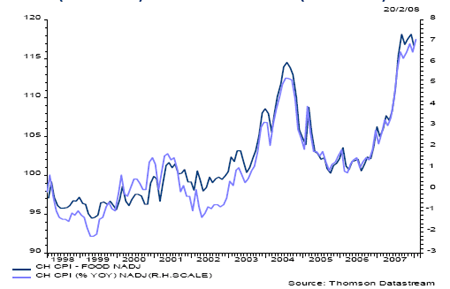
According to the latest data release, annualised Chinese inflation increased to 7.1% in January. It’s been on a steadily rising trend since mid-2006 and if the economy continues to over-heat could hit 10.0% before the end of 2008.
We have long argued that the Chinese authorities must give serious consideration to unpegging the renminbi. The consequences of not doing so, using aggressive monetary policy to curb inflationary pressure, risk hitting the economy hard and raising the prospect of widespread rioting in the run-up to the August event.
Readers will be aware that the number of Western newspaper articles on the subject of the backdrop to the Olympics have increased markedly over the past few weeks. It is clear from their tone that the risks to the stage managed nature of the event have risen. We do not disagree.
Food prices drive CPI rise
Chinese Consumer Price Inflation (CPI) reached 7.1% in January, a new peak. The underlying cause of the latest increase was the widespread incidence of pig disease, which drove food price inflation above 18% year on year. The recent bad weather is likely to drive CPI inflation even higher over the next few months. We have argued, before, that measuring inflation excluding food and energy (at the very least) leads to a misleading picture as everybody has to eat and most people make use of energy (i.e. drive a car etc).
Food prices amount to 37% of Chinese CPI. Therefore the 18% annualised increase in food price inflation amounts to 6.7% of total CPI, the vast majority of the reported 7.1% figure. The huge weight accorded to food prices in the calculation of Chinese inflation makes it entirely clear that food is by no means noncore in the Chinese context!
Food price inflation (LH scale) and Chinese CPI (RH scale) are closely correlated
What is also entirely obvious is that in relatively poor countries (China’s per capita income is roughly one eighth of that of the United States) food represents a proportionally more significant expenditure than anything else and that the recent price acceleration has everything to do with a sharp increase in demand. As the chart (below) shows, Chinese Gross Domestic Product (GDP) has been rising sharply over the past few years.
While much of the growth in the Chinese economy can be ascribed to strong growth in investment and export activity, supporters of the Chinese (and Asian) ability to decouple from the economic downturn in the West have set much store in the country’s aspirational consumers saving less and consuming more. Although we have been sceptical on this point we accept that strong growth in consumer demand may indeed be contributing to the latest surge in activity levels, to the extent that the economy is now operating above potential for the first time this decade. This spells one word…overheating!
Given that the weight of potential Chinese consumption is akin to that of a supertanker, once it starts moving it develops significant momentum of its own. The inevitable conclusion is that rising consumer demand will, in all likelihood, continue to underpin an overheating economy and drive inflationary pressure yet higher over the months ahead.
It hardly needs saying but this situation leaves the Chinese authorities in a very precarious and certainly unsustainable position. Doing nothing is no longer an option. An overheating economy will, inevitably, result in more inflationary pressure. Monetary policy, which has already been tightened aggressively, will have to be tightened yet further, increasing the pressure on the population and risking instability in the critical run-up to the Olympic Games, a point at which the eyes of the world (not just the eyes of economists and politicians) will be focused squarely on the country.
A free-floating currency is the only option
The only sensible (and long overdue) option left to the authorities is to allow the currency to float freely on the foreign exchanges. The previous chart shows how the Chinese currency has accelerated against the dollar over the past two years or so as Chinese authorities have gradually relaxed the peg. Much as Beijing may wish to avoid having its economic policy options held in an arm lock by the Western speculators it purports to despise, the inevitability of a freely floating Chinese currency is now one of the more obvious and potentially lucrative trades around.
A wall of speculative cash now sits in the renminbi awaiting the inevitable. As things stand the only uncertainty is “when” not “if” the Chinese decide to float their currency. What looks now like a one-way bet may eventually become a trade fraught with risk once the decision is made, particularly as, by so doing, the massive structural imbalances characterising the global economy should begin to unwind. The decision to float the Chinese currency freely would be momentous to say the least!
By Jeremy Batstone-Carr, Director of Private Client Research at Charles Stanley